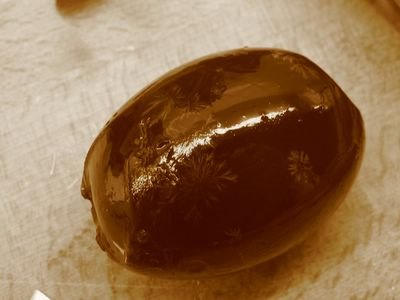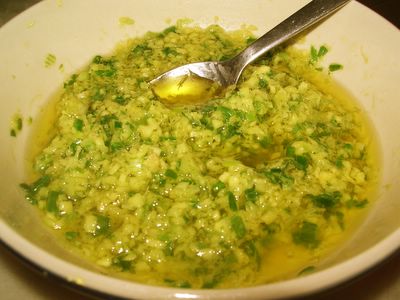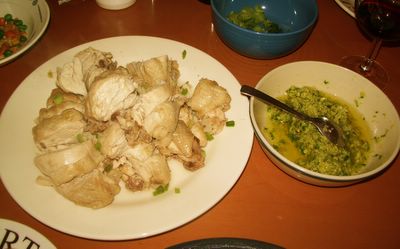Pho (pronounced like 'fun' without the 'n') is a traditional Vietnamese noodle soup, characterized by its beef and anise flavor. My friend showed me this Vietnamese recipe one day, when I was still living in Dublin. The most difficult part for us was finding the beef bones. She said that they traditionally use large bones with plenty of marrow in them, but the closest we could find in Dublin butcher shops were ox tails. The other ingredients can be found in any Asian market.
Smiling onions.
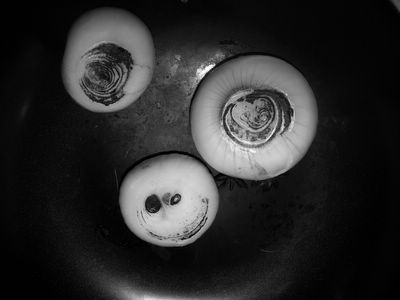 click to enlarge
click to enlargeTo describe Pho, I'd say it's a rather delicate dish consisting of rice noodles, meatballs, and beef chunks in a very distinctive broth. It's warming enough to serve in the colder seasons, yet light enough to have as a nice meal in the spring time.
Vietnamese Beef PhoPreparation time: 20 min
Cooking time: 3 hrs
Ingredients:Few pounds of large beef bones cut 3-4 inches in length. Ox tails work well because they contain both meat and marrow. *A reader also recommended fillet mignon (read at bottom of post).
2 packages of Vietnamese Pho rice noodles (see picture)
1 large package of frozen Asian meatballs (~20)
1 large Daikon radish
3-4 whole star anise
3 large white onions
Salt
Green onions, finely chopped [optional]
Cilantro [optional]
Dipping sauce for meats:Hoisin sauce
1 lemon
Chili paste
Serves 4-6
STEP 1 - Clean the bonesRinse the bones in cold water. Place in a large pot with enough water to cover the bones. Bring to a boil; then pour out the boiling water. Give the bones another quick rinse under the tap; then fill the pot with enough water for your soup. Heat to a boil. This is a traditional Asian step for making soup from bones, and will yield a clearer broth.
STEP 2 - Make the brothPeel onions, leave whole, and slice of tips. Peel the Daikon radish, cut into 3 pieces. While the beef broth is coming to a boil, heat up a heavy duty frying pan. Sear the flat sides of the onion and the anise (not the radish). This will bring out some of the flavor in the broth.
Once seared, place all three into the broth.
Daikon radish is pungent, yet delicious.
 click to enlarge
click to enlargeAnise is good.
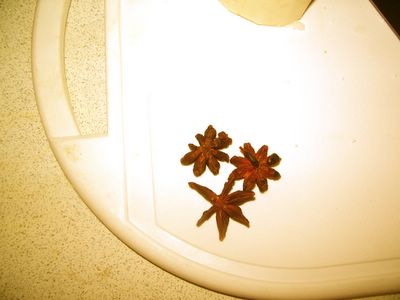 click to enlarge
click to enlargeReady to be seared.
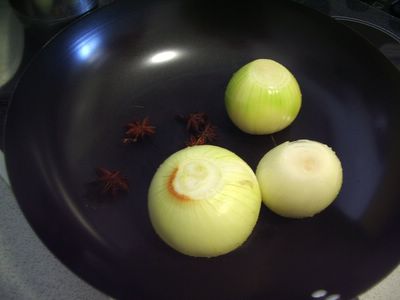 click to enlarge
click to enlargeWhen nicely seared, place the radish, anise, and onion in the broth.
 click to enlargeSTEP 3 - Watch and wait
click to enlargeSTEP 3 - Watch and waitOnce the broth comes to boil, reduce it to a simmer, cover (partially if necessary) and let sit for 2.5 hours.
Meanwhile, you can pre-cook the noodles according the package directions, the idea being to laddle the Pho broth over cooked noodles.
Vietnamese rice noodles. Go for the thin ones and follow package instructions. [Hint: the microwave is great for cooking them up once they've been softened in hot water]
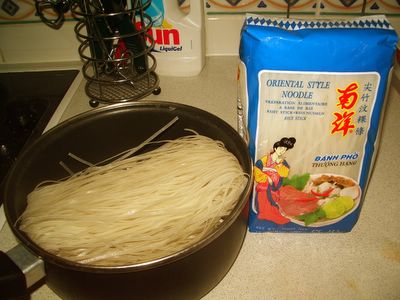 click to enlargeSTEP 4 - Flavor Step
click to enlargeSTEP 4 - Flavor StepOnce the broth has simmered for 2.5 hours, add the meatballs and let them cook for the remaining 30 min. Before serving, enhance the broth with a liberal amount of salt.
The Pho broth after 2.5 hours of simmering. Now would be a good time to add the meatballs.
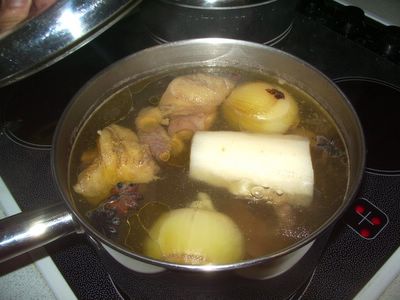 click to enlargeSTEP 5 - Serving
click to enlargeSTEP 5 - ServingPlace a serving of cooked noodles into a bowl. If noodles have gone cold, you can heat them up in the microwave or briefly dunk them in boiling water. Ladle the broth and meatballs onto cooked noodles. Place one ox tail (2 if they're small) in the soup bowl. Take out the Daikon radish chunks, and slice into 1/2 inch disks. Place one or two pieces in the noodle bowl.
*Note that you can always make the ox tail and radish optional by serving them on a plate in the middle of the table.
Garnish with fresh cilantro and green onions. Serve with the dipping sauce for meats [see below for instructions].
Homemade Pho with Ox Tail
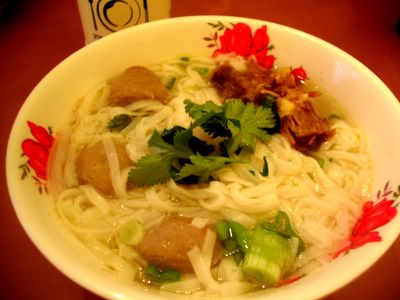 click to enlarge
click to enlargePreparing a dipping sauce for the meatballs and ox tail. This sweet-sour-spicy dipping sauce consists of hoisin sauce, chili paste, and fresh lemon juice.
 click to enlargeVARIATION - Phollet Mignon
click to enlargeVARIATION - Phollet MignonThis suggestion came from a reader, and I like it!
Hi Lexman. Read your Pho recipe today. Good stuff; I never thought of searing the anise and I always wondered why I couldn't get enough flavor out of it. A couple things: one, you don't mention basil at all in your recipe. To me, nothing makes a good bowl of pho than freshly torn Thai Basil. Also, try out this variation I came up with: Buy one fillet mignon of the highest quality and slice into pieces about 1/8" thick and 2"x2" or so. Sit them on top of your noodles and pour the boiling broth over top slowly. This method cooks the beef to a near-perfect medium temperature and I guarantee you will not eat a more tender, flavorful piece of meat ever. I call it "Pholet Mignon". Hope you like it!
Lee Iovino
Leesburg, VA









